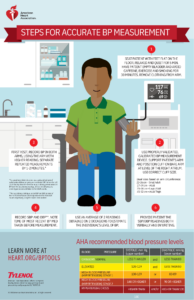Blood Pressure Uncuffed™ Volume 1: 4 Steps to Taking a Proper BP (Blood Pressure) Measure
November 16, 2023. By Sophie Cook
When your blood pressure is taken at a doctor’s visit or at home, do you usually sit in silence for 5 minutes? Have your legs ever been crossed? Have you ever talked during a measurement? Like most of us, we are not aware of how to properly take a BP measure. Having accurate and reliable results is incredibly important so you can track and see trends in your health. To obtain those readings you must follow 4 essential steps.
#1: Prepare
Thirty minutes prior to taking your BP you should not smoke, drink caffeine, or exercise. If you engage in any of those activities right before taking your BP, it could artificially increase it, giving you a false sense of high blood pressure.
You should empty your bladder before you take your measurement. When your bladder is full, it exerts pressure on the kidneys, leading to higher blood pressure (1).
There are many factors that occur before and during the reading that may affect accuracy (6). These are:
- Stress
- Alcohol and Caffeine Consumption
- Tobacco Use
- Cold Temperatures
- Full Bladder
- Talking
- Texting
- Crossing your Legs
Take crossing your legs for example. When you take your blood pressure with your legs crossed it can cause your BP to increase. The result being that your measure shows an overestimation of your true BP (2). One reason this may happen is due to increased blood being pumped to the chest when you cross your knees, which causes your heart to pump more blood, therefore raising your BP. Another reason this may happen is because the muscles in your legs increase the resistance to the blood trying to pass through, which then causes higher BP (3).
Or what if you take your BP in cold temperatures? Your blood pressure can change depending on the climate. In the winter when it is cold outside, your BP is higher than in the summer when it is warm outside. Why is that you may ask? Lower temperatures cause your blood vessels to narrow, meaning more force is being exerted to get through the narrow vessels (4). Versus when you are hot, your blood vessels may dilate causing a drop in BP.
#2: Sit Correctly
After you have prepared to take your measure by following the above steps, ensure you are seated in a chair with your back supported, legs uncrossed, and your feet flat on the floor (5). The arm being used to take the measure should be laid on a flat surface (i.e. table) with the upper arm at heart level.
Being seated in a chair at a table is preferred rather than being seated on a sofa or recliner chair. Soft surfaces do not offer proper support needed when taking a blood pressure measure.
Rest in the seated position for 3-5 minutes before you take a measure. Any kind of activity (walking, vacuuming, carrying groceries) can increase your BP. So, to ensure you are getting a true resting BP measure and not a falsely elevated one, be sure to rest for 3-5 minutes to regulate your body to its natural resting state. This will provide for the most accurate results.
#4: Recording
It is ideal to take at least 1 measure in the morning after waking up, and 1 measure at night before going to bed, and it is important to stay consistent with the time of day you measure for the most accurate results (5). If monitoring your blood pressure due to doctors’ orders, follow their instructions on when to measure*
Each time you do a reading you should take two measures separated by 1 minute of rest (5). This is to ensure a true rested reading. You can average your two readings together for your result and record that if desired.
Make sure whatever kind of blood pressure monitoring device you are using for these measures is suitable for you (i.e., Size, fit).
Next time you have your BP taken think about these 4 important steps: Prepare, Sit Correctly, Rest 3-5 minutes, and Record Consistently. It is important to track and monitor your health, but it is even more important to do so accurately.
Sources:
- https://www.adventisthealth.org/blog/2021/february/your-bladder-and-blood-pressure/#:~:text=When%20the%20bladder%20is%20full,haven’t%20noticed%20problems%20yet.
- https://pubmed.ncbi.nlm.nih.gov/10450120/#:~:text=Conclusions%3A%20Blood%20pressure%20increases%20when,when%20measuring%20their%20blood%20pressure.
- https://irishheart.ie/news/heart-of-the-matter-can-crossing-your-legs-raise-your-blood-pressure/#:~:text=Another%20explanation%20is%20that%20when,the%20ankles%2C%20just%20the%20knees.
- https://www.mayoclinic.org/diseases-conditions/high-blood-pressure/expert-answers/blood-pressure/faq-20058250#:~:text=Answer%20From%20Francisco%20Lopez%2DJimenez,through%20narrowed%20veins%20and%20arteries.
- https://www.heart.org/en/health-topics/high-blood-pressure/understanding-blood-pressure-readings/monitoring-your-blood-pressure-at-home
- https://www.thocc.org/about/news-press/news-detail?articleid=42152
